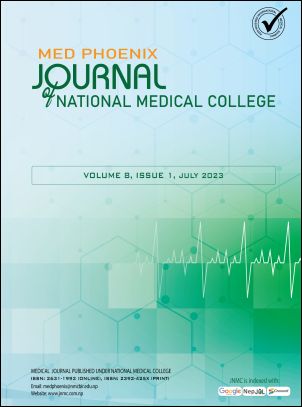Sonographic Measurement of The Splenic Length in Adults and its Correlation with Different Parameters
DOI:
https://doi.org/10.3126/medphoenix.v8i1.56923Keywords:
Body Surface Area, Height, Sonography, Splenic Length, WeightAbstract
Introduction: Splenic length is an important parameter for many splenic pathologies. Ultrasonography has been an efficient tool for the measurement of different splenic parameters including the splenic length. The objective of this prospective study was to determine the splenic length in healthy adults without any hematological, oncologic or traumatic condition and to correlate it with age, sex, height, weight, body surface area of the body.
Materials and Methods: A total of 360 healthy subjects were included in this study conducted for a period of 6 months. Informed written consent and ethical approval were taken. A detailed clinical history of all the patients were taken. Basic investigations, clinical and ultrasonography examination were performed. Then the data collected was analyzed by MS Excel and SPSS 25 program.
Results: The study included 360 participants (180 male & 180 female) with mean age of the 40.39 ±11.51 years. The mean splenic length was found to be 9.11±1.16 cm. There was significant correlation of splenic length with age, weight, height and body surface area. The splenic length was higher in male compared to female ineach age group.
Conclusion: The study aimed to establish the normal range of spleen length and to examine its correlation with body height, weight, and surface area in male and female subjects. The researchers found that spleen length decreases with age in both sexes. Additionally, spleen length increases with body height, weight, and body surface area. Female spleen length is less than male spleen length for corresponding ages.
Downloads
Downloads
Published
How to Cite
Issue
Section
License
Copyright (c) 2023 Med Phoenix

This work is licensed under a Creative Commons Attribution 4.0 International License.
Copyright on any research article is transferred in full to MED PHOENIX upon publication. The copyright transfer includes the right to reproduce and distribute the article in any form of reproduction (printing, electronic media or any other form).
© MEDPHOENIX
![]()
Articles in the MED PHOENIX are Open Access articles published under the Creative Commons CC BY License (https://creativecommons.org/licenses/by/4.0/). This license permits use, distribution and reproduction in any medium, provided the original work is properly cited.




